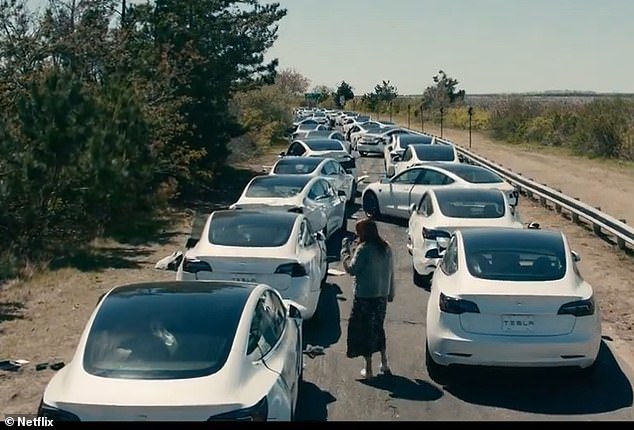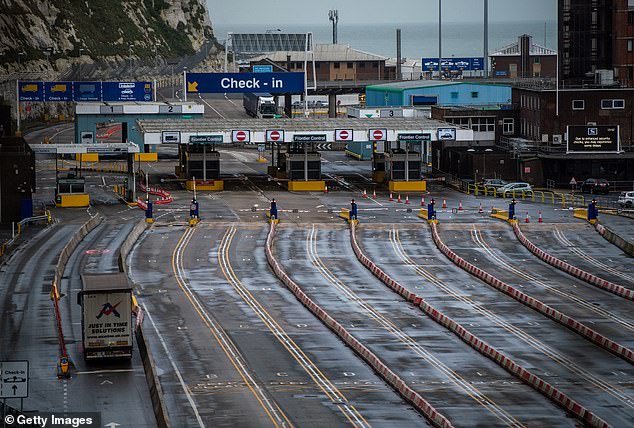An explosion like a bomb shook the windows. All the lights went out. Along the street, despite the torrential rain, neighbours were peering out of their windows and doors to see the twisted TV aerial where the bolt of lightning had struck.
But the real damage went much deeper. A single electrical surge during a thunderstorm fried internet modems and routers in more than a dozen houses around my Bristol home.
It was four days before my family’s service was restored – four days that had me struggling to do my work over the wi-fi in coffee shops, or sending emails via the mobile phone network.
The heating and the music system, both tethered to the internet, refused to work. And a few days after the storm, once we were back online, a global outage took down Amazon’s ‘cloud’ provider, a vast facility that enables countless features on the worldwide web, from banking services at Lloyds and Halifax to social media platforms such as Snapchat and Reddit.
Even Amazon’s own brands were disabled, including Alexa smart speakers and Ring doorbells. We live in a society where, if the internet goes down, the doorbell doesn’t work.
Temporary though these interruptions were, both incidents – my personal experience and the international tremor – highlight the fragility of a 21st century world entirely reliant on invisible, electronic data transfers.
That fragility is now understood very well by two major British businesses, Marks & Spencer and Jaguar Land Rover.
Last April, a ‘ransomware’ attack on M&S enabled hackers to encrypt all the company’s online operations. Internet sales were blocked for weeks, and broken supply chains meant shelves were sometimes empty.
On day two of the blackout, police and the Armed Forces are ordered on to the streets in London, Manchester, Glasgow and other major cities in an attempt to control looting, which is rampant
The incident will cost Marks & Sparks around £300 million. But it was dwarfed by the cyber attack on Jaguar Land Rover last August which shut down the car manufacturer’s production lines for five weeks and cost the British economy an estimated £1.9 billion.
On Friday the company reported that a £398 million profit last year had turned into a £485 million loss this year, plus another £196 million in cyber-related costs.
Practically no one stops to think how we could fix the internet in the event of a total shutdown, given that most of the information needed to repair it exists only within the internet itself. Think of it as a gigantic bank vault, containing all the world’s riches of information. What happens if it slams shut… with the combination locked inside?
Here, based on predictions by cyber security experts as well as the evidence of recent system meltdowns and hacker attacks, is a timeline of how the worst-case scenario could unfold.
And the most terrifying part is this: just like the lightning strike that took out the internet on a single Bristol street, the obliteration of the global internet is most likely to start with a single natural event… one that can be neither predicted nor prevented.
What we do know is that the first shockwaves may already have hit us. Readers across Britain who enjoyed last month’s spectacular aurora borealis – or Northern Lights – displays might not have been aware of the damage this phenomenon was causing.

On Tuesday, a massive solar flare burst out from the Sun triggering a coronal mass ejection (CME), a huge cloud of solar material and magnetic fields, that races towards the Earth at about 3,000 miles per second
On Tuesday, a massive solar flare burst out from the Sun triggering a coronal mass ejection (CME), a huge cloud of solar material and magnetic fields, that races towards the Earth at about 3,000 miles per second.
Solar flares are graded in five categories: A, B, C, M and X, with X being the largest.
Within those levels, the flares are numbered, doubling in strength with every whole number – A2, for example, is twice as powerful as A1.
Last week’s CME was classified as X5.1, the biggest in more than a year. Flares of this magnitude are capable of disrupting satellites, high-altitude flights and high-frequency radio.
Sure enough, radio blackouts were reported in Europe and Africa – the side of the planet facing the Sun when the waves from Sunspot AR4274 hit.
‘In most events, these particles are absorbed by the atmosphere and don’t reach the ground,’ said Dr Ryan French, a solar physicist at the Laboratory for Atmospheric & Space Physics in Boulder, Colorado. ‘But in this flare, we measured what is called a ground-level enhancement, where these particles did make it to the ground.’
Particles from such powerful solar flares have hit the Earth fewer than 100 times since records began in 1942. But there is evidence of a much bigger geo-magnetic storm almost a century earlier. The Carrington Event of 1859, named after astronomer Richard Carrington, filled the atmosphere with such intense electrical activity that telegraph wires across Europe and North America burned out.
Sparks flew from pylons, and Morse code operators on the network suffered electric shocks. In places where the lines remained usable, operators reported that they could send signals without battery power – the electricity in the air was enough to convey them.
No storm that powerful has hit the Earth since. But that could be about to change. Here we imagine what could happen to today’s technologies if the sun expelled an even bigger solar flare.
DAY ONE 15:00 GMT
As Sunspot AR4274 explodes again, the first blast of magnetic energy from the biggest coronal mass ejection ever known bombards the Earth. It is eventually graded at X11.6 – making it roughly 100 times more powerful than the November 11 event.
It reaches our planet travelling four times faster than its predecessor, because the previous blast has cleared clouds of plasma out of its path, like an Olympic curler brushing debris off the ice in order to speed up the progress of a team-mate’s stone.
In the split seconds before the first pulse hits Earth, thousands of satellites are knocked out of action – crippling the mobile phone and GPS networks, as well as military ‘eyes in the sky’ spy networks.

As Sunspot AR4274 explodes, on board the International Space Station, every circuit fails, shutting down the oxygen supplies and sparking multiple fires. The seven crew members are dead within minutes
On board the International Space Station, every circuit fails, shutting down the oxygen supplies and sparking multiple fires. The seven crew members are dead within minutes.
Across Western Europe, the United States and Canada, the effects are cataclysmic. Massive electrical surges fry the components in every device plugged into the mains. Computers, televisions, fridges and all manner of household gadgets burst into flames.
Tens of thousands of people suffer serious electric shocks. Hundreds of cardiac pacemakers stop working, despite their robust shielding.
The National Grid fails, as overhead power lines fuse. Traffic lights conk out, as do street lamps, with the result that there is an epidemic of car crashes in every city.
The emergency services would be massively overwhelmed if anyone could get through to them. As it is, all their phone systems have failed.
Not only are the satellites out of action but thousands of miles of copper wires in vital cables burn out. Fibre-optic cables are not susceptible to solar-storm damage, but relay stations that boost their signals over long distances are.
Within minutes, fires are blazing everywhere and, with the fire brigade forced to rely on spotters with binoculars to direct operations, many burn out of control. In the absence of radio and TV transmissions and with all communication systems disabled, chaos and confusion reigns.
Without air traffic control, and with many onboard instruments non-responsive, every aircraft landing is perilous. Mid-air collisions occur between private jets and airliners over two US airports, in both cases with the loss of all lives.

Without air traffic control, and with many onboard instruments non-responsive, every aircraft landing is perilous. Mid-air collisions occur between private jets and airliners over two US airports, in both cases with the loss of all lives
17:00 GMT
It’s 8pm in Moscow and president Vladimir Putin’s security service, the FSB, is piecing together what they know of the catastrophe in the West. The worst of the coronal mass ejection has missed Asia, which was in darkness, facing away from the Sun at the crucial moment.
Because of the loss of its satellites, Russia has lost access to the global internet but it has its own intranet, an internal communications network created to insulate the country from punitive US shutdowns.
By switching to this back-up system, known as RusNet, the Kremlin is able to keep essential services running, including phone networks and social media. Russian glee at the West’s meltdown is unbounded, and TV commentators immediately predict the breakdown of American and European society.
In Beijing, it is past midnight. Chinese foresight means the chaos on the other side of the world barely touches them. They too have their own self-contained national intranet.
DAY TWO 06:00 GMT
Downing Street ordered the Army to set up a government comms system 12 hours ago. This is now operational, using field telephones and military radios.
With only the most rudimentary connections, Morse code proves the surest way of transmitting messages.

Most of the major roads are impassable, due to abandoned electric cars. The Army requisitions bulldozers to clear Britain’s motorways
Police and the Armed Forces are ordered on to the streets in London, Manchester, Glasgow and other major cities in an attempt to control looting, which is rampant. Most of the major roads are impassable, due to abandoned electric cars. The Army requisitions bulldozers to clear Britain’s motorways.
Back-up generators are keeping the lights on in hospitals, but much of the equipment – from heart monitors to MRI scanners – is useless.
All scheduled operations are cancelled, and A&E departments are completely overwhelmed. The most common injuries are due to burns and smoke inhalation from the countless fires still raging.
09:00 GMT
Prime Minister Keir Starmer summons cyber-experts to tell him how Britain’s essential power, comms and electronic systems can be restored.
Limited electricity supplies and phone signals are already being reinstated, but all online links remain wiped out.
Professor Alan Woodward from the University of Surrey explains: ‘The internet is a remarkably fragile thing – a critical piece of our economic infrastructure, built on very shaky foundations.’
As a priority, he recommends restoring power to the London Internet Exchange in Telehouse, in the Docklands, a hub for much of Britain’s cyber traffic.
But it is impossible to know whether any of America’s main cloud data centres have survived irradiation. Without them, huge computing arrays will have to be replaced and programmed. The internet will essentially have to be rebuilt from scratch.

Older people are coping best, the ones who grew up in an era without the internet. Gen Z and younger Millennials are worst affected. They have lost the only means they know of connecting with the world
15:00 GMT
Just 24 hours after the disaster, Britain is reverting to a social order that seems almost medieval. All resources – food, power, water, fuel – are being shared, either voluntarily or by force.
Those with portable generators, such as builders, are using them to light and heat community halls.
Drinking water is especially valuable, and the Army is attempting to organise distribution of bottled water, while water companies struggle to get the taps flowing again.
A pattern is already emerging. Older people are coping best, the ones who grew up in an era without the internet, when TV, household appliances and even cars were a luxury.
Middle-aged adults are rigid with panic, stripped of all the electronic aids they’ve come to take for granted.
But it is the teenagers and young adults, Gen Z and younger Millennials, who are worst affected. They have lost the only means they know of connecting with the world. To be without social media and streaming video is like becoming suddenly deaf, dumb and blind.
Supermarket employees, realising that their shelves will quickly be stripped bare by looters, are throwing open the doors and inviting the public to take what they need for free. This encourages people to behave with more restraint than if they felt they were stealing. The tills are out of action in any case.
So is the entire banking network. Payment cards are just rectangles of plastic… and every Bitcoin millionaire is instantly penniless.
Cash is in short supply, though criminal gangs in some cities are targeting cashpoints – no CCTV cameras are working, after all.

Britain’s supply chains are not operating, ports are closed, there’s no haulage lorries and no way of restocking supplies, from petrol to food
Speed cameras are also not functioning, and with all police ordered on to city streets to maintain order, the roads are becoming race tracks for drivers in stolen cars.
This won’t last long – every petrol pump is out of order. Even if the pumps were working, there are no fresh fuel deliveries, because all the logistics systems are down.
The same is true of all Britain’s supply chains: no ports, no haulage lorries, no way of restocking.
TWO MONTHS ON
As the West struggles to get back online, the hackers emerge – both the organised crime gangs and the enemy saboteurs.
Every makeshift computer system, cobbled together from cannibalised kit and running on hastily written code, is wide open to attacks.
The Government is repeatedly held to ransom by cyber-criminals, many with covert help from Beijing. Russian interference is more blatant. Putin orders infiltrators to target surviving electronic infrastructure, often by means as crude as arson.
As Britain attempts to re-establish robust links with the US, his trawlers target the undersea cables.
Our food deliveries are not getting through. Thousands are dying every week from cold. Cholera and other diseases spread through unfiltered water supplies.
Britain, which survived two world wars and decades of social upheaval, is on the brink of obliteration – all because of a single natural disaster and our total reliance on an electronic network no stronger than a cobweb.
dailymail,news,Bristol,Earth,Amazon
#solar #flare #destroys #National #Grid #internet #Electricity #planes #banks #hospitals #fail #fridge #explodes #Lootings #rampant #thousands #freeze #Terrifying #Experts #shockingly

